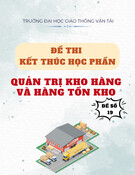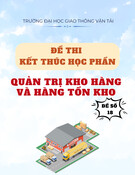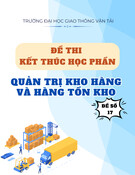
FTU Working Paper Series, Vol. 1 No. 1 (01/2022) | 37
TỔNG QUAN VỀ HIỆP ĐỊNH THƯƠNG MẠI TỰ DO VIỆT NAM – HÀN
QUỐC VÀ MỘT SỐ KHUYẾN NGHỊ CHO ĐƠN VỊ XUẤT KHẨU TÔM
VIỆT NAM
Nguyễn Phương Anh1, Vũ Nguyễn Thu Trang, Chu Thị Minh Phương,
Nguyễn Sinh Khang
Sinh viên K59 Logistics & Quản lý chuỗi cung ứng – Viện Kinh tế và Kinh doanh quốc tế
Trường Đại học Ngoại thương, Hà Nội, Việt Nam
Vũ Huyền Phương, Nguyễn Minh Phương
Giảng viên Viện Kinh tế và Kinh doanh quốc tế
Trường Đại học Ngoại thương, Hà Nội, Việt Nam
Tóm tắt
Tôm là một trong những mặt hàng của Việt Nam được thị trường Hàn Quốc đặc biệt đón nhận và
ưa chuộng bởi chất lượng, giá cả phải chăng, phù hợp với nhu cầu tiêu dùng của người dân bản
địa. Mặt hàng tôm xuất khẩu đã bước đầu tận dụng được các lợi thế từ Hiệp định Thương mại tự
do Việt Nam – Hàn Quốc hay Vietnam – Korea Free Trade Agreement (VKFTA), nhưng hiệu quả
thực sự không được như kỳ vọng. Dựa trên việc đánh giá thực trạng lẫn những thách thức của mặt
hàng tôm đang đối diện, nhóm tác giả sẽ cung cấp bài viết nhằm đưa ra cái nhìn tổng quan về hiệp
định VKFTA. Qua đó, nhóm tác giả nhận thấy rằng để nâng cao tỷ lệ tận dụng ưu đãi mà VKFTA
mang lại cho mặt hàng tôm, các doanh nghiệp cần tiếp cận rõ ràng hơn thông tin về VKFTA để
lựa chọn các ưu đãi phù hợp với điều kiện của doanh nghiệp và đồng thời cần có những thay đổi
về công nghệ, định hướng phát triển sản phẩm theo hướng phù hợp hơn với nhu cầu của thị trường
nhập khẩu. Cùng với đó, nhóm tác giả cũng đề xuất một số biện pháp giúp thúc đẩy xuất khẩu mặt
hàng tôm và đáp ứng kỳ vọng của hiệp định VKFTA mang lại.
Từ khóa: Vietnam-Korea Free Trade Agreement, mặt hàng tôm xuất khẩu.
AN OVERVIEW OF VIETNAM – KOREA FREE TRADE AGREEMENT AND
RECOMMENDATIONS FOR VIETNAM SHRIMP EXPORT
UNDER ITS IMPACT
Abstract
Shrimp is one of Vietnam's products that is especially well received and favored by the Korean
market because of its quality, affordable price, and suitability for the consumption needs of local
people. It was perceived that exporters of shrimp products attempted to take advantage of benefits
provided by the Vietnam – Korea Free Trade Agreement; however, the result was not as predicted.
In this context, the writers will present an overview of the agreement in a paper, thereby, the
Working Paper 2022.1.1.03
- Vol 1, No 1

FTU Working Paper Series, Vol. 1 No. 1 (01/2022) | 38
authors discovered that in order to increase the rate at which businesses take use of the incentives
provided by VKFTA for shrimp goods, firms require better access to information about VKFTA
in order to select incentives that are appropriate for their circumstances. At the same time, there
should be changes in technology and product development orientation in a direction that is more
suitable to the needs of the import market, which is based on an assessment of the current situation
and challenges of shrimp products being faced. Furthermore, the authors propose a variety of
measures to help promote shrimp exports and achieve the requirements of VKFTA.
Keywords: VKFTA, shrimp products.
Literature Review
There have been a great number of researchers who show their concern over the economic
impact of VKFTA on Vietnam.
Ngo (2017) made use of Heckscher-Ohlin theory, along with a systemizing method, to observe
the advantageous product lines that would best benefit Vietnam exporters in the Korean market
and make suggestions based on such observation. Among the highly-esteemed products is seafood,
which was pointed out by the author as a firm line of goods that had a remarkable market share in
the Korean market, giving incentives for future studies about seafood exports in general.
Jeong and Phan (2016) used general equilibrium to provide an assessment of the potential
economic impacts of the Vietnam-Korea free trade agreement on Vietnam. Furthermore, this study
used CGE methodologies to analyze a variety of areas of the potential consequences of the
Vietnam-Korea FTA; however, the results are limited due to the peculiarities of the models and
data used. In addition, the current study does not consider the potential economic effects of other
types of economic cooperation other than trade concerns.
Phan (2016) utilized trade indices as a method to indicate the current situation and prospects
of Vietnam-Korea bilateral trade, thereby suggesting the directions for developing the bilateral
trade relation between the two countries. This research pointed out the characteristics of Vietnam-
Korea trade relations, changes in trade composition, and which products had dominated the trade
and enjoyed a comparative advantage. In this paper, the researcher referred to the trend and
structure of Vietnam-Korea trade based on a table of statistics “Vietnam’s trade with Korea by
Sector in 2014”. Nonetheless, the researcher only scrutinized generally based on the figures given
and had not specified comprehensively in terms of each sector.
Due to the rapid expansion of shrimp farming land, which is increasing the number of
households involved in the sector, and the impact of trade policies on the shrimp business in our
nation, Ngo (2013) used quantitative and qualitative approaches to collect data. The rise of shrimp
production in the Delta has accelerated in recent decades due to trade liberalization and other
policies supporting aquaculture. Although there are several policies aimed at promoting shrimp
farming, there is no policy linked to the output of shrimp products, according to this study. Farmers
must rely on a network of middlemen that attempt to exploit shrimp farmers throughout the
process. Nevertheless, this paper has not mentioned the specific solutions to solve problems in
trade policy.
However, in terms of its effect on Vietnam’s shrimp export to Korea, there has not been any
thorough research, which acts as a motivator for the writers to carry this out.

FTU Working Paper Series, Vol. 1 No. 1 (01/2022) | 39
1. An overview of VKFTA
1.1. Introduction of VKFTA
The Vietnam - Korea Free Trade Agreement took effect in December 2015, contributing to
bringing economic and trade relations between the two countries to a new level. Korea is the third
largest trading partner and the largest investor in Vietnam. Therefore, the signing of the modal
FTA with these countries will open up many great opportunities for export and investment
cooperation for Vietnamese enterprises with this market. With stable demand, high export prices,
and tax incentives thanks to the ASEAN-Korea Free Trade Agreement and the VKFTA
Agreement, Korea is considered a potential alternative market with many growth opportunities.
for shrimp exporters in the context of exporting to main markets facing many difficulties. In order
to take advantage of tax opportunities brought by VKFTA, shrimp processing and export
enterprises need to be more proactive in strictly controlling quality indicators, updating procedures
and market requirements. At the same time, businesses also need the companionship of state
agencies to fully meet the requirements and maintain the above markets.
1.2. Main content of VKFTA
According to WTO (2019), the Agreement consists of 17 Chapters (208 Articles), 15 Annexes
and 01 Agreement on implementation regulations.
Based on the ASEAN – Korea commitment, Viet Nam has committed to add more 265 tariff
lines which import turnover from Korea of 917 million USD. The list includes: materials for the
textile and garment; plastic materials; electronic components; automotive parts; electrical
appliances; some iron and steel products; electric cable; trucks of g.v.w from 10-20 tonnes and
automotive of a cylinder capacity exceeding 3,000 cc (WTO, 2019).
Korea’s commitment includes 506 items which 4 items have the current MFN rate of 0%. The
other 502 items which Korea agreed to eliminate the tariff have the total import turnover from
Vietnam of 324 million USD. Korea has pledged to provide Viet Nam tariff elimination and quota
for key export commodities of Viet Nam such as: fishery products (frozen and canned shrimp,
crab, fish); agricultural products; tropical fruits and industrial goods such as textile, garment,
mechanical products, garlic, ginger, honey, red beans, sweet potatoes... (WTO, 2019).
2. Vietnam and Korea’s commitment in VKFTA regarding shrimp export
2.1. Commercialization of goods
2.1.1. Commitments on tariff
Important commitments in VKFTA are based on the commitments previously established in
FTA ASEAN – Korea (AKFTA), but with a higher level of liberalization. There are additional
tariff lines to be cut aside from those in AKFTA, as follows:
Korea will eliminate an addition of 506 tariff lines while Vietnam eliminate 265 of them. With
the combination of VKFTA and AKFTA’s commitments on tariff, it is established that (WTO,
2019):
+ Korea will eradicate 11,679 tariff lines (accounting for 95.44% of the tariff and equivalent
to 97.22% of the total import turnover from Vietnam to Korea in 2012) for Vietnam. Especially
for frozen cold-water shrimp peeled, shell on cold-water shrimp, other shrimp and prawn shrimps

FTU Working Paper Series, Vol. 1 No. 1 (01/2022) | 40
that have been peeled, shrimp and other prawn shrimps not peeled, live/ fresh/chilled cold-water
shrimp, live/fresh/ chilled shrimp and other prawn shrimp, shrimp and shrimp prawn are not
airtight canned – which tax rates were reduced from 20% to 0%.
+ Vietnam will eradicate 8,521 tariff lines (representing 89.15% of the tariff and 92.71% of
total Korea-Vietnam import turnover in 2012) for Korea.
2.1.2. Commitments on Rules of Origin
Goods will be considered to originate from a Party (Korea or Vietnam) if being able to fulfill
one of the conditions that dictate the origin of any goods trading between the Parties, like: being
completely produced or wholly obtained within the territory of the exporting Party, fulfilling the
Regional Value Content (RVC) – which is typically over 40%, … (WTO, 2019)
Even if goods do not meet the origin criteria for HS code conversion, they are still considered
originating if they meet some special criteria, which will allow this section of goods to receive
specific treatment (WTO, 2019).
As for shrimps exported by Vietnam, it falls in the category of being wholly produced or
obtained as long as being taken by vessels registered with the Party and within the territorial seas
of Vietnam. Thus, cold-water shrimps and prawns (Pandalus spp., Crangon crangon) and other
shrimps and prawns whether live, fresh or frozen are under the protection of VKFTA (WTO,
2019).
2.2. Commercial Service
The two Parties agree to common regulations and obligations to ensure the interests of each
Party's service providers when accessing the other Party's service market. Each Party shall provide
the following basic benefits to the other Party's service and service suppliers: National Treatment
(NT), Most Favored Nation (MFN) and Market Access (WTO, 2019).
With respect to sectors with commitments, each Party shall not adopt or maintain measures
that affect service suppliers of the other Party, such as restrictions on the number of service
providers; restrictions on transaction value… or restrictions on the total number of human
resources to be used, depending on the specific content of the commitments. Especially among the
non-tariff measurements, the quotas applied to Vietnamese shrimp was a 10,000-ton exemption in
the first year VKFTA was applied, which rose to 15,000 tonnes 5 years later (WTO, 2019). With
this, Vietnam shrimp export will have an advantage compared to other countries, giving exporters
opportunity to grow in the Korea market.
3. VKFTA and Vietnam’s export of shrimp products to Korea
3.1. Overview on Vietnam's shrimp exports to Korea
3.1.1. Vietnam’s shrimp exports from 2010 to 2014
Looking back at Vietnam's shrimp exports, it has met with exponential growth.
In 2010, Vietnam reached an important milestone as the shrimp export industry made great
profits for the first time in history, exporting over $2 billion in value and had a high growth rate
of 25 percent compared to that of 2009. However, this industry, together with Vietnam’s economy,
collapsed amidst the global economic recession in 2012 with negative growth (Vietnam
Association of Seafood Exporters and Producers - VASEP, 2018). Despite the downfall one year

FTU Working Paper Series, Vol. 1 No. 1 (01/2022) | 41
prior, during 2013-2014, Vietnam’s shrimp exports met a dramatic comeback as over $3 billion
and almost $4 billion dollar respectively worth of shrimp were traded internationally (VASEP,
2018).
Figure 1. Shrimp Export Value (2010-2014)
Source: Authors
3.1.2. Vietnam’s shrimp exports to Korea from 2010 to 2014
It was clear that Vietnam’s shrimp exports value has been a promising industry with an
uprising trend in 2013-2014, with overall good growth in many importing countries including: EU,
U.S, Korea… Taking up 7.9% of total shrimp export value during that period, Korea proved its
place as Vietnam’s 5th biggest shrimp importer in 2014, following the United States, Japan,
European Union and China (Nguyen, 2014).
In 2013, according to The Observatory of Economic Complexity (2021), the value of shrimp
and prawns export to Korea racked up to about $225 million, taking the 2nd place among seafood
exports to this country. Compared to China, which is the biggest crustacean exporter to Korea, this
value is slightly smaller with a 40 million difference; moreover, Vietnam beat Malaysia and
Thailand from the 3rd and 4th place by a huge amount.
Figure 2. Shrimp Export Value in 2013
Source: Authors
In 2014, according to VASEP (2014, cited in Nguyen, 2014) and Vietnam News Agency (cited
in Cơ hội lớn để xuất khẩu tôm sang Hàn Quốc, 2015) it was recorded that the biggest shrimp
-10%
0%
10%
20%
30%
40%
0
1
2
3
4
5
2010 2011 2012 2013 2014
US billion $
Year
Shrimp Export Value (2010-2014)
Shrimp Export Value (US billion $) Growth (%)
050 100 150 200 250 300
Vietnam
China
Malaysia
Thailand
US$ million
Shrimp Export Value in 2013


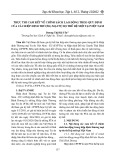
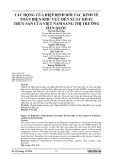
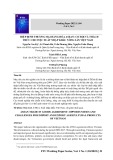
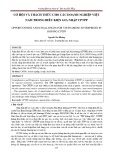











![Đề kiểm tra Quản trị logistics [mới nhất]](https://cdn.tailieu.vn/images/document/thumbnail/2025/20251015/2221002303@sv.ufm.edu.vn/135x160/35151760580355.jpg)
![Bộ câu hỏi thi vấn đáp Quản trị Logistics [năm hiện tại]](https://cdn.tailieu.vn/images/document/thumbnail/2025/20251014/baopn2005@gmail.com/135x160/40361760495274.jpg)
